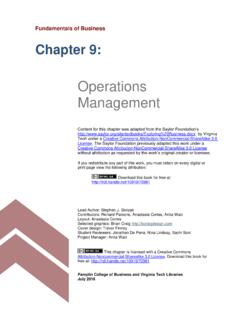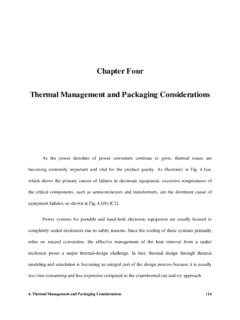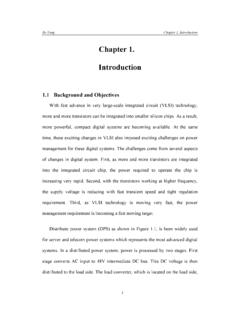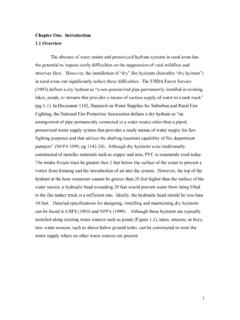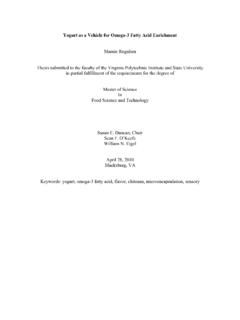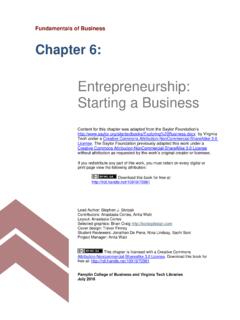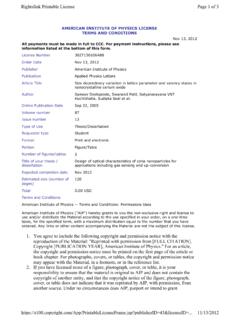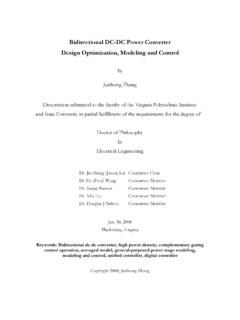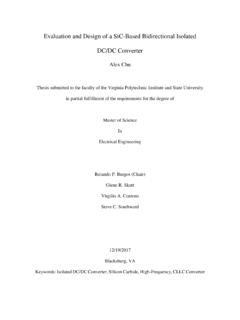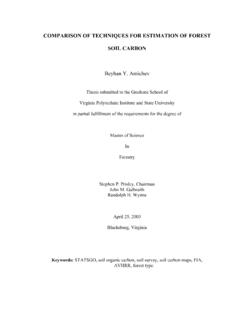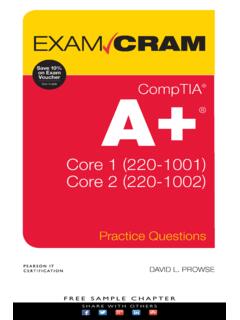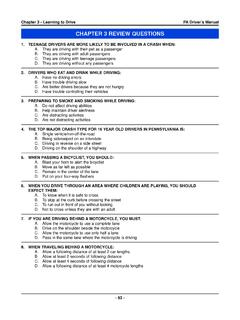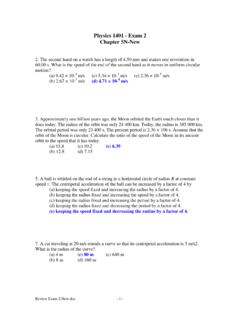Transcription of Chapter 2 REVIEW OF RELATED LITERATURE - Virginia Tech
1 10 Chapter 2 REVIEW OF RELATED LITERATUREI ntroductionPresented in Chapter 2 is a synthesis of research thatsupports the evaluation of the attendance policy andattendance program of Newport News Public Schools. Included inthe Chapter is a historical overview of attendance, theimportance of attendance, overview of Newport News PublicSchools, theoretical framework, causes or predictors ofstudent absenteeism, descriptions of RELATED attendancepolicies/ programs, and a REVIEW of perceptions and attitudesabout attendance policies/programs as indicated by OverviewEarly homesteading laws allowed the settlers free landon which to build schools.
2 Schooling was perceived as the keyto success for individuals and to the excellence of society(Mitchell, 1993). Free and compulsory education came toEngland and Wales following the Elementary Education Acts of111870 and 1876, although not always on a full time basis. TheEducation Act of 1918 finally abolished half timeschooling, and made elementary education entirely free andcompulsory until the end of the term after the child'sfourteenth birthday. Nevertheless, in most parts of theUnited States the problem of illegal absence dates from 1876(Galloway, 1985). In the 1850s urban schools suffered from anextremely high turnover of students. Many students wereneeded at home to do many of the chores, especially if theylived on a farm. Other students worked outside of the home tohelp support the family.
3 Poor attendance was a problem toteachers and parents well before school attendance becamecompulsory (Pallister, 1969). Pallister notes that enthusiasmfor education varied with the standards of the school; goodschools quickly obtaining the support of parents, andsimilarly bad schools, least in the eyes of parents, quicklylosing administrators were immediately faced with newconcerns considering that in 1900 only 6 percent of Americanshad a diploma (Wise, 1994;Kay, 1991). It is clear thatattendance rates varied little between 1904 and 1938, exceptin 1920 when lower average attendance followed the socialupheaval of the First World War. Galloway noted that there islittle evidence that attendance rates over the last ten tofifteen years (1970-1985) differ very much from those earlierin the century (Galloway, 1985).
4 Even with the increased12attendance and the increased graduation rates over the last100 years, education is relatively the same. A glaringexample of this is the release of students for farm work inextremely industrialized society. Our culture has changed butthe reasons for excused absences have not changed (Wise,1994).School attendance was a problem before education becamefree and compulsory, and based on the researcher's knowledgeand experience as an educator, it has continued to be one eversince. The researcher notes that attendance figures can beinterpreted in different ways. There is little evidence thatschool attendance rates have changed noticeably throughout thetwentieth century. Importance of AttendanceGovernment officials, teachers' groups, and individualparents all have voiced their concerns over the need todevelop policies and practices to counteract the problemsfacing our nation's schools today such as the dropout rate,drug abuse, and declining education performance (Bernstein,1990).
5 Poor school attendance arouses strong feelings inteachers, parents, members of the educational supportservices, educational administrators, politicians, and pupils. These strong feelings are expressed in different and often13contradictory ways, depending on the individual's ownperspective (Galloway, 1985). The statistics RELATED to school absenteeism arestaggering. Each school day, 2,500,000 students are reportedabsent from school. The dropout rate is estimated at 27percent nationally and over 45 percent in some cities. The 27percent dropout rate equates to 65 busloads of students wholeave United States schools each week and do not return. In ayear's time, 700,000 students will be lost. In two years, thenumber will exceed one million (Person, 1990).
6 The Virginia Department of Education has created asystem for better and more accountable schools through what isnow called the Outcome Accountability Project (OAP). Thisprogram establishes the criteria for how schools and schooldivisions will be held accountable for meeting the commitmentof improving learning for all. The data from the OAP providesa framework for analyzing the school district by breaking thewhole into some of its attendance data for secondary students provided bythe OAP for the State of Virginia indicates that 66 percent ofstudents in grades 9-12 during the school year '95-'96 wereabsent 10 days or less from school. The OAP data furtherlists Newport News Public Schools as having 55 percent of itsgrades 9-12 students absent 10 days or less from school (OAPR eport, 1997).
7 The school philosophy, in general, is one thatstresses to teachers, pupils, and parents the importance of14regular school attendance. This is because it is the beliefthat only through regular school attendance can studentsprogress academically at a successful rate (Jett & Platt,1979). Attendance is part of a pupil's cumulative record. Itis important that good school attendance habits be establishedfor later years when pupils seek employment (Jett & Platt,1979). Jett and Platt conclude that attendance and itsimportance should be taught to students. Basic to thatphilosophy is the belief that poor student attendance andtruancy are some of the first signs of decay of a school andschool system. Therefore, it is incumbent upon educators todo all they can to promote good school attendance habits amongtheir who has skipped or had to repeat a grade, hasbeen placed in or excluded from a special program, or has beendenied academic credit because of absences knows theimportance of local school policies.
8 While scholarlyattention has tended to focus on federal and state educationpolicy, those who attend and work in schools realize thattheir lives can be affected greatly by policy made at theschool and district level (Duke and Canady, 1991).Guba (1984) identifies eight distinct conceptions ofpolicy. They include the following:Policy is an assertion of intents or is the accumulated standing decisions of agoverning body, by which it regulates, 15 controls, promotes, services, and otherwiseinfluences matters within its sphere of is guide to discretionary is a strategy undertaken to solve orameliorate a is sanctioned is a norm of conduct characterized byconsistency and regularity in some substantiveaction is the output of the policy-making is the effect of the policy-making andpolicy-implementing system as it is explainedby the researcher believes that each of the aboveconceptions by Guda has some value for the study of schooldistrict and school policy.
9 Duke and Canady (1991) refer toschool policy as any official action taken at the district orschool level for the purpose of encouraging or requiringconsistency and regularity. They further state that thedefinition implies intentionality on the part of thosedeveloping (1983) refers to school policy as fitting into anecology of public policies. In other words, where theoperation of pubic schools is concerned, a range of policy16sources can be identified. Pizzo further states that policiesare derived from Congress, the Department of Education, thecourts, state legislatures, intermediate agencies, schoolboards, and school-based personnel. To understand educationalpolicy in the United States, it is necessary to understandeach of these policymaking entities and the relationshipsamong and Canady (1991) identify three reasons to studypolicy.
10 First, many of the education policies likely to havea direct effect on the lives of students, parents, andteachers are local school policies. A state legislature maypass legislation concerning the allocation of resources foreducation, but the legislation does not become meaningful forclients, patrons, and employees until local policy decisionsdetermine how the available resources will be utilized. Second, schools serving similar groups of students can differgreatly in areas such as student achievement, attendance,dropped rate, teacher morale, and school climate. The thirdreason to study school policies according to Duke and Canady(1991) is the fact that the number of locally developedpolicies is likely to increase in the future. Interest inshared decision making, teacher empowerment, school-sitemanagement, and the restructuring of schools suggests that thelocus of educational policymaking may be shifting.
